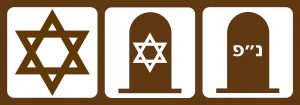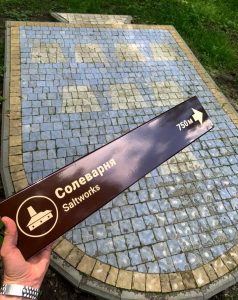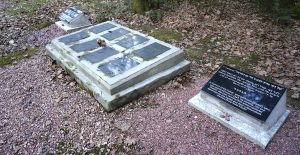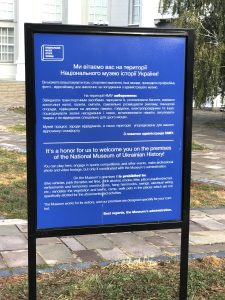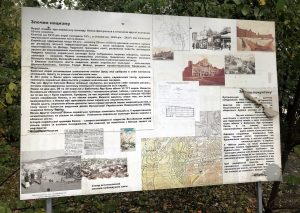![]() Ця сторінка також доступна українською.
Ця сторінка також доступна українською.
Introduction

A site identification and memorial sign at the Jewish cemetery of Obertyn (Ivano-Frankivsk oblast). Photos © RJH.
Physical signs are essential to lead visitors to Jewish burial sites, to mark and identify the cemeteries and mass graves, and to provide historical information about the sites and the communities who are buried there. If a burial site is not at immediate risk of erosion or other damage, often the installation of physical signs is one of the most useful and least expensive project options for manifesting and promoting the Jewish site as an element of regional shared heritage.
Unfortunately, there are few defined standards or other guiding resources for the design and development of directional, identification, and information signs in western Ukraine. This serious deficit is apparent from the very brief list of applicable print and web references related to signage linked to this website, although there are several useful resources for information design, wayfinding, and general exterior signage from loosely-related sources for or about other regions.

Proposed design for an information sign at the old Jewish cemetery in Rohatyn
(Ivano-Frankivsk oblast). Image © RJH.
On the plus side, a lack of standards and laws also means that there are few regulatory constraints on the format, construction, and installation of signs marking Jewish burial sites. The generally low cost of fabricating and erecting signs also means that original signs can be easily replaced if new sign standards are implemented and enforced in the future.
So, project leaders and activists may use the existing standards as guidance but may also take inspiration and ideas from the few examples in western Ukraine, the larger number across the country, and numerous examples elsewhere in Europe and beyond. A number of those examples are depicted below. Signage design should integrate materially with site landscape work, but also conceptually with surveys, memorial designs, and communication work. Near the bottom of this page is a brief discussion with recommendations for sign design, materials, and installation, plus life expectations for physical signs.
This page is intended to aid the development of installed permanent physical signs only; for other forms of signs (e.g. markers and information on internet and paper maps, mobile phone touring applications, etc.) see the guide page for communication on this website.
Directional Road Signs

Bilingual signs on streets of Bolekhiv (Ivano-Frankivsk oblast) directing visitors to the Jewish cemetery. Photos © RJH.
Road signs directing drivers to heritage sites are important for their basic purposes of aiding route decisions and route monitoring (elements of the process of wayfinding). But directional road signs are also valuable for alerting travelers to the presence of these sites, about which many people passing through the area may know nothing beforehand. Very few Jewish cemeteries and mass graves in western Ukraine face major roads, so directional signage is needed in most cases. Typically, more than one sign is needed to indicate a route from major roads to the burial site, with signs placed near each intersection where a direction change or other decision must be made.
The sizes, shapes, colors, symbols, and typefaces of road signs are standardized and carefully controlled in Ukraine and elsewhere in Europe, for safety and clear communication. However, there are no standards or laws currently in effect in western Ukraine for signs which direct drivers specifically to heritage sites. Portions of the available standards may be applied directly to burial site projects, and others may be adapted for heritage uses, but differences in Ukrainian and European rules create gaps and conflicts which project leaders, sign designers, and local government administrations must reconcile.

Example images and specifications for road sign symbols, arrows, and lettering from the Ukrainian national standard.
The most region-relevant reference is a Ukrainian national standard called Road signs: General specifications; Rules of application (Знаки дорожні: Загальні технічні умови; Правила застосування – see the signage references page); a pdf version of the document is available for free download. The standard is clear and specific for many types and features of road signs, and includes 24 symbols for different services and sites, but only one which might be applicable to heritage sites: a general category and looped-square symbol for a “notable place”, which is used for similar purposes in at least ten other European countries. Sign colors are limited to blue, white, and black, with only a few markings and fields in green, yellow or red. The use of alternate foreign-language place names is defined. Signs directing drivers to heritage sites (including cemeteries) can be designed from these guidelines, but symbols which clearly indicate the type of site would have to be devised.

Example images and specifications for road sign symbols, arrows, and lettering from the Vienna convention.
A broader, Europe-wide agreement on the design of road signs, on which Ukraine is a signatory, is the Vienna Convention on Road Signs and Signals (listed on the signage references page, and also available for free download). Covering both direction and identification signs (among many other types), the convention provides prescriptive guidance and specifications (in text form) as well as color reproductions of each of the defined sign types. The road sign category F covers all information, facilities, and service signs but includes only 15 types and symbols, none of which is applicable to heritage sites. Sign design rules differ somewhat from the Ukrainian national standard in arrow shape, the placement of symbols in relation to text and arrows, and other details. As for the Ukrainian national standard, this convention can be extended to use for indicating cemeteries, with the same approach of adaptation.

Examples of standards for arrows plus symbols for tourism sites and public behavior in ISO 7001. Images © ISO/IHS.
Another standard which may guide the development of provisional symbols for Jewish heritage sites and for cemeteries is the international standard ISO 7001 on Graphical symbols — Public information symbols (see the signage references page). Applicable to both direction signs and identification signs, this standard aims to make the symbols on signs recognizable from a distance and intelligible regardless of the viewer’s native language. In addition to specifications for the shape and orientation of direction arrows, six categories of symbols are tabulated, each with several or many defined symbols. The “tourism, culture, and heritage” category currently includes no heritage symbol examples, but the graphical design of the overall collection can help shape original designs for other applications. Copies of standard are for sale by ISO, but useful reviews and summaries can be found elsewhere.
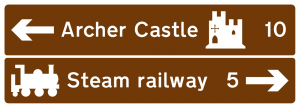
A heritage traffic sign example in the UK. Image © Crown copyright.
Curiously, none of these references defines the brown-and-white sign coloring used in many national standards and guidelines for historic monuments and heritage sites in Europe, and more generally for tourist sites of all types (e.g. in the United Kingdom, Germany, Sweden, and Greece). Although far from universal, the brown color sets these information road signs apart visually from signs intended for safety and vehicle lane control (which are almost always blue), and can alert approaching drivers to heritage tourism opportunities en route, even before the symbols and text on the signs are legible. It is unknown at this time whether Ukraine and other countries will move toward greater use of brown for indicating heritage sites in the future, but the color and its associations with heritage is already well understood by many travelers.
In practice in western Ukraine (and across the country), road signs indicating routes to Jewish cemeteries and mass graves, or related heritage sites, vary considerably, conforming to no single standard. Some Ukrainian examples shown here include a small sign pointing to the Karaite Jewish cemetery and a historic Christian temple in the city of Halych (Ivano-Frankivsk oblast), with brown and white coloring, unique symbols, and non-standard arrows; a sign pointing to the mass grave complex north of Drohobych (Lviv oblast), in blue and white with no symbol and with the arrow formed by the sign field (similar to the Vienna convention); a pair of bilingual signs directing drivers to the Jewish cemetery in Bolekhiv (see also project case study 15 on this website), mostly following the Ukrainian standard with reversed white and blue coloring and no symbols; and a sign indicating a Holocaust memorial in Bakhiv (Volyn oblast), with brown and white coloring and the Ukrainian standard arrow shape, but no symbol.

Examples of Ukrainian road signs pointing to Jewish burial sites in Halych, Drohobych, and Bakhiv. Photos © RJH and Oksana Sushchuk.
Elsewhere in Europe, signs for Jewish burial sites conform more or less to the Vienna convention but still with considerable variation. Examples include a set of tourist signs in Prague (Czech Republic) indicating the old Jewish cemetery and two synagogues, conforming to ISO 7001 in style and arrows but with brown and white coloring and using custom symbols; two Jewish heritage directional signs for sites near Šeduva (Lithuania) with brown and white color, national arrow forms, and Stars of David; and bilingual Jewish heritage signs pointing to the Jewish cemetery and a Holocaust memorial in Niš (Serbia), in brown and white colors with arrows conforming to ISO 7001, plus custom symbols.

Examples of European road signs pointing to Jewish burial sites in Prague, Šeduva, and Niš. Photos © Ruth Ellen Gruber or via Jewish Heritage Europe.
Lacking complete, clear, and consistent standards or other references, some activists aim to borrow from the available standards and create designs which may promote informal guidelines for other projects in the region. Proposed directional road signs for the old cemetery in Rohatyn (Ivano-Frankivsk oblast) follow the Ukrainian national standard for sign sizes, corner radii, arrow form, typeface, and bilingual text, substituting brown coloring for the standard blue, and adding a custom symbol in the form of a Star of David. Alternate symbols for consideration include a rounded Jewish headstone silhouette (distinct from crosses typically used to depict Christian cemeteries) with a Star of David, and a similar headstone shape with the common Hebrew epitaph abbreviation identifying the deceased, “Here Lies”.
Directional Pedestrian Signs
Direction signs to indicate walking routes for visiting Jewish burial sites should be scaled and designed specifically for pedestrians, i.e. to be viewed and interpreted at close distance, and installed on sidewalks and foot paths. Directional pedestrian signs are important not only in urban areas where sight lines are obstructed by buildings, but also in more remote areas where access to burial sites may require a walking route which leaves roads and well-worn paths for some distance.
There are no known Ukrainian or other European standards for pedestrian signs; it appears that typically municipal administrations and/or tourism offices contract for the development of standards and the pedestrian signs as well, or develop their own guidelines and design rules.
However, there are many examples of physical pedestrian signs in larger towns and cities of Ukraine, including in the western Ukrainian cities of Lviv, Rohatyn, and Drohobych. Several examples of signs intended to help visitors locate heritage in Lviv and Rohatyn are shown here. The signs are usually grouped in clusters or “trees” on vertical poles anchored in sidewalks near well-touristed street intersections or in popular pedestrianized squares, indicating several heritage buildings and sites in three or four directions. Each individual sign on the tree includes a bilingual name of the heritage feature, a symbol representing the type of feature or sometimes its unique visual profile, and an arrow to indicate the direction of the walking route. The signs are consistently colored a deep shade of brown in the field with contrasting white text and symbols.
A pedestrian sign developed by the city of Drohobych (Lviv oblast) and its tourist office shows similar design elements, with similar effectiveness. The sign is one of 165 planned for a second phase of city marking to aid and encourage heritage tourism.

Examples of directional pedestrian signs around the center of Rohatyn, including arrows pointing toward Jewish heritage sites. Photos © RJH.
Site Identification Signs
Guidelines for aiding the wayfinding process include recommendations for destination recognition at the end of the route, in essence a final step in route monitoring. A common and effective approach to identifying a site uses similar or identical sign elements at the site as are used in the directional signs which lead to the site. An example from a proposal for the old Jewish cemetery in Rohatyn (Ivano-Frankivsk oblast) is shown here; the identification sign corresponds closely to the directional sign shown above. Differences in the identification sign include further detail in the text (the era of the cemetery’s establishment) and the addition of Hebrew as a third language, but otherwise the sign shape, symbol, typeface, and colors are the same as proposed for the directional signs.
Even where no directional signs have been installed, the same standards and guidelines described in the section above on those signs may provide useful reference for the development of identification signs. Identification signs for cemeteries are typically installed at the entrance to the site or at key road or walking path junctions adjacent to the site, as shown here in the Rohatyn example.

Pavement QR codes for heritage sites in Lviv. Photos © Lviv Travel.
Another type of physical sign can identify heritage sites for pedestrians, using QR codes to name and describe the sites in a mobile phone application. The official tourist office in the city of Lviv in western Ukraine has created a series of pavement markers made of durable printed ceramic which include QR codes linked to web pages which identify and describe the city heritage features in front of which they are placed. The images from the tourist office Facebook page shown here tempt passers-by to learn more about what they see, and coordinate with planned walking tours developed by the tourist office. Similar approaches could be used in many towns and cities with several or many heritage sites, including Jewish burial sites.
Information Signs
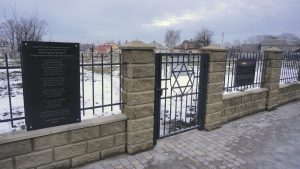
Trilingual information signs installed by ESJF at the new Jewish cemetery in Zbarazh (Ternopil oblast). Photo © RJH.
Apart from a very small number of elderly people, the local western Ukrainian communities in the area around Jewish cemeteries and mass graves often know very little about these burial places, their history, and the Jewish community to which they relate. If the locations of Jewish burial sites are largely unknown, directional and identification signs can help. Resources to provide further information about the sites, for both the local populations and visitors traveling through the region, depend on a different type of sign, usually placed at a cemetery entrance, a boundary fence or marker, or within the perimeter of the site; for mass graves, these signs are typically incorporated into a memorial marker or separately installed near or within the grave sites, if they are known.
Information signs at Jewish burial sites can include many different types of content, tailored to the site, the available research, the sign materials and construction, and the sign’s intended purpose. Some of the types of content which may be considered for an information sign include:
- a history of the burial site (prewar, wartime, postwar)
- a history of the Jewish community which is buried there
- mention of and explanation about prominent persons buried there
- a map of the site and location of other Jewish heritage sites in the area
- historic photographs with explanatory text relevant to the site
- cultural history (e.g. headstone symbolism and epitaph inscriptions)
- a summary of planned or ongoing project work at the site (aka a project ‘passport’)
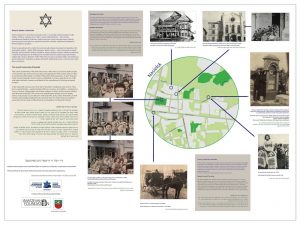
A trilingual information sign at the Jewish cemetery of Nasielsk, Poland.
Image © the Jewish community of Nasielsk.
It is common for information signs to include text in two or more languages. In our area of study and project work, Ukrainian is the most important of these languages, to speak to the local Ukrainian community. English is a helpful second language, not only to inform visiting Jewish descendants from Anglophone countries, but also as the modern lingua franca for foreign visitors from across Europe and beyond. Modern Hebrew is also helpful, to include visitors from Israel as well as other religious Jewish visitors who do not read English. Other languages (e.g. Polish) may be useful as well if local or historical circumstances warrant their inclusion or substitution.
Space for information in multiple languages is typically very tight on signs of practical size and with typeface font sizes which are legible in an outdoor setting, and printed, etched, or cut onto durable materials. Some signs intended for information purposes are so brief in explanation that they serve more for identification only. The selection of text and other media to include on the sign must prioritize what the project leader and sign designer consider the most important or essential to the site. Additional information in digital formats without size constraints may be included on web pages and sites linked to physical signs at burial sites via QR codes and mobile phone applications; this approach is already routine in more recent sign designs.
Examples of installed physical information signs are rare at Jewish cemeteries in western Ukraine, and only slightly more numerous at mass grave sites. The case study 15 on this website shows two examples at burial sites in Bolekhiv (Ivano-Frankivsk oblast) and describes a third. Other examples shown on this page include a multi-panel historical and cultural display sign at the old Jewish cemetery in Rava-Ruska (Lviv oblast) plus historical and site description signs at a mass grave near the edge of that city; a survivor’s bilingual memorial sign at an entrance to the forest which envelops mass graves near Ralivka (Lviv oblast) and another at the Jewish cemetery of Staryi Sambir (Lviv oblast); and a bilingual version of the prayer El Malei Rachamim installed on a monumental stone together with a Soviet-era memorial plaque on the footpath leading to the mass grave complex north of Drohobych (Lviv oblast).

Information signs at western Ukraine Jewish burial sites in Rava-Ruska (3 examples), Ralivka, Staryi Sambir, and Drohobych. Photos © RJH.
Beyond this region one can find examples of information signs which may serve as models for content, design, and construction in western Ukraine; useful guidance may also be found in information signs at non-Jewish heritage sites. Shown here are several different types from the Jewish mass grave complex at Babyn Yar in Kyiv (central Ukraine); a dense sign at the destroyed Jewish cemetery of Lukyanivka (a neighborhood in Kyiv); a well-designed example at the Jewish cemetery of Nasielsk (Poland); the installation by the TAMUS organization of a visitor information panel at the Jewish cemetery of Pořejov (Czech Republic); a sign introducing a wildlife feature of the historic castle site high above Gjirokastër (Albania); and one of many informative signs around ancient monuments now revealed at Delphi (Greece).

Examples of European information signs at Jewish burial sites and elsewhere, including four at Babyn Yar plus individual photos at Lukyanivka, Pořejov, Gjirokastër, and Delphi.
Photos © RJH.
Other Physical Signs
Many other types of physical signs may be placed at or near Jewish burial sites, and a number of these have been installed at cemeteries and mass graves around western Ukraine:
- signs on ohels identifying the tsadiks and their family members buried there, and on symbolic ohels where the actual grave cannot be located
- Holocaust memorials at cemeteries which commemorate local Jewish community members lost elsewhere
- signs or plaques commemorating named individuals and families
- signs acknowledging burial site project donors or soliciting donations to support further work
- markers with numbers or other signs corresponding to features on walking tours of the site
A few examples are shown here from larger sites, including the Jewish mass grave complex north of Drohobych (Lviv oblast) and the massive mass grave site at Babyn Yar in Kyiv (with the adjacent erased Jewish cemetery of Lukyanivka). Large killing and mass grave sites require significant resources for protection and commemoration, and many relatives of the victims understandably feel a need to recover and perpetuate individual names from the multitudes.
Design considerations for these other sign types are specific to the purpose and the sites of installation, and are beyond the scope of this guide, although ideas and details may be adapted from the examples shown here and from signs depicted elsewhere on this page.

Other sign types at the Babyn Yar memorial reserve, and a symbolic ohel at the Lukyanivka cemetery. Photos © RJH.
Design, Materials, Installation, and Sign Longevity
The previous sections of this page considered the content and information design of several types of signs leading to or located at Jewish burial sites. Any complete sign design must include specification for the sign materials and assembly and for the sign installation at the site. Fabrication, assembly, and mounting of a sign should be considered early in the design phase, as the sign construction process will influence the sign’s many design elements affecting its appearance and intelligibility.
Simple sign designs can be created on a computer with ordinary office and/or photo editing applications, although often the color space used by those applications is not perfectly compatible with professional printing and sign fabrication services; for many simple signs this will not be a serious issue, and printers can adjust colors to match standards or color samples. More complex text and image designs can be created using desktop publishing (DTP) software (free open-source applications are available); these applications often include common color printing model outputs such as CMYK.
The blue background color characteristics in some road sign standards is defined in those documents for printing. The brown color which appears in many directional and site identification signs is not universally standardized for use in Ukraine, but European Norms (EU standards) in current effect for road signs may be referenced, and other similar standards can also be compared. EN 12899-1/2007 (Fixed, vertical road traffic signs – Part 1: Fixed signs; available in various country-adopted languages) specifies the brown color on signs using CIE 1931 chromaticity coordinates with eight corner points of a tolerance box in three dimensions. Separate specifications are given for photoreflective and non-photoreflective signs; the approximate center points of these allowable ranges, with corresponding approximate conversions to digital displays and common printing specifications are:
photoreflective: xyY = 0.50375 0.39825 6.0 sRGB = 107, 56, 21, 0 css = #6B3815 CMYK 0-100 = 0.000 47.503 80.164 58.131
non-photoreflective: xyY = 0.45475 0.37525 9.5 sRGB =125, 74, 51, 0 css = #7D4A33 CMYK 0-100 = 0.000 40.891 59.628 50.925
For comparison, the US federal highway standard (Code of Federal Regulations: Title 23, Chapter I, Subchapter G, Part 655, Subpart F: Traffic Control Devices on Federal-Aid and Other Streets and Highways) specifies the brown color for tourist signs in the same chromaticity coordinates as:
photoreflective: xyY = 0.487 0.3865 6.5 sRGB = 110, 59, 31, 0 css = #6E3B1F CMYK 0-100 = 0.000 46.381 71.623 56.999
The US brown color specification is also provided above with corresponding conversions to other formats as for the European Norm. The US standard also identifies this brown as most closely matched by the Pantone system color code 469C (which has slightly different matching sRGB, css, and CMYK values).
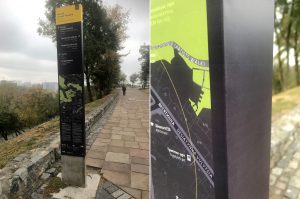
A printed vinyl information sign wrapped over a steel-reinforced concrete base at the National Museum of Ukrainian History in Kyiv. Photo © RJH.
Each of these standards allows considerable variation within the acceptable specification limits, so that printers may easily select or mix colors from their suppliers; see the individual standards for the full specifications. There is also a very helpful Wikipedia article comparing European road sign standards, which visually contrasts their specified brown colors for “tourist” signs.
EN 12899-1/2007 also specifies a large number of other physical requirements for road signs, but the standard is intended for testing and inspection so does not include construction guidelines or specifications for materials, dimensions, and fabrication; it cannot be used as a “recipe” for sign design, assembly, or installation.
Guidance for creating directional and identification signs can of course be learned from studying comparable signs in the local region, in particular those created and installed by official road crews at the national or regional level. Municipal administrations also can advise about suitable contractors for fabricating signs and supports, and may have suitable sample sign specifications for reference. Similarly, guidance for physical design and construction of information signs is likely best learned from commercial sign fabricators; bringing a concept and content image to a discussion with one or more commercial sign printers or fabricators can provide information on known good design features, and may lead to a useful partnership. Some examples of information sign construction are shown here in photographs.
The durability of all materials and installation components is a very important consideration in any sign design. All signs installed at burial sites should remain intact and legible despite year-round weather cycles (which can be harsh in western Ukraine) as well as minor accidents and simple vandalism. Sign fabricators typically will not guarantee the life of an outdoor sign and its mounting beyond one or two years, though project activists often have expectations that a sign will last for many decades. Some signs do last longer than 10 years (in particular when constructed of aluminum or aluminum layered composites with baked paint coverings), but it is best to plan ahead for renewal or replacement, and choose materials carefully, including UV-resistant inks and protective coatings. One approach to extend the life of information signs, which we are not aware of in use in western Ukraine, is employed by the Greek Ministry of Culture and Tourism on many outdoor archaeological sites: a printed ceramic panel mounted to a concrete base plate and pillar support. The printing process permits selective use of color, fine resolution of text and line graphics, and halftone-rendered photographs, giving high information density with a very durable finish, as shown in the images on this page.

Information signs constructed of printed ceramic at the archaeological sites of Kassope and Delphi in Greece. Photos © RJH.
Theft of metal signs (as well as metal supports) is an ongoing issue in western Ukraine, as metal is a valuable resale resource in the economically-depressed region. While signs constructed of aluminum, for example, are especially durable against the regional weather, the attachment of these signs to their frames and supports, and the anchoring of those supports into the ground or other structures, should be made as robust and theft-resistant as possible. It is also wise to ensure that all specifications and designs for a sign are well documented so that signs can be replaced if needed.
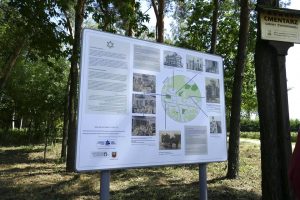
Information sign installation at the Jewish cemetery in Nasielsk, Poland. Image © the Jewish community of Nasielsk.
As anywhere, ordinary vandalism of signs (graffiti, other marks, and other damage) is a routine annoyance in western Ukraine, and in some cases is permanent and obstructive; as for theft, allowance for occasional replacement of sign panels is recommended in project plans and budgets. Beyond intentional damage and loss, other reasons for sign modifications include changes to URLs for web pages with additional information about burial sites and the associated Jewish communities; adhesive labels with updated QR codes may be required for printed signs, and other modifications for etched or carved signs.
Costs for sign fabrication and installation can vary widely depending on size and selected materials and finishes. One information sign project for a 1.5m by 1.0m aluminum sandwich with printed vinyl overlay, mounted in a galvanized and painted steel channel frame and installed on galvanized and painted steel pipe posts which were anchored in concrete cost about US$600 to print, assemble, and install; the layout and design of the sign information content was a separate cost (provided mostly by volunteers in this case). As more sign projects are identified and investigated for this website, we will update this information with specific details and costs.


